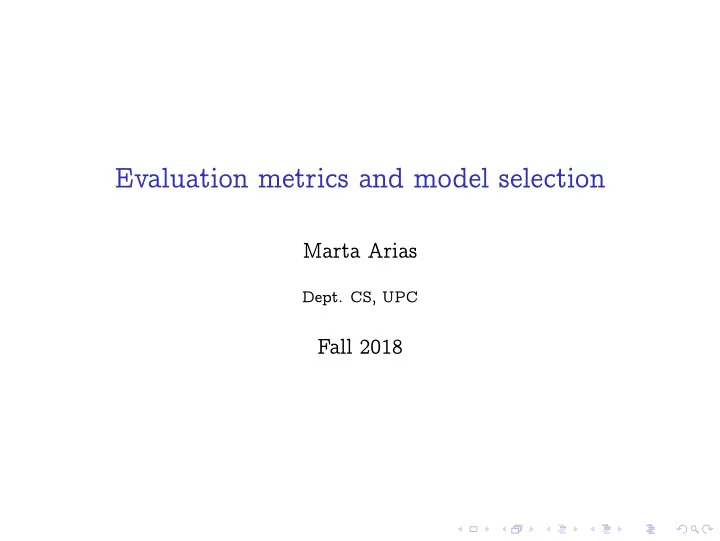

Evaluation metrics and model selection Marta Arias Dept. CS, UPC Fall 2018
Quantifying the performance of a binary classifier, I x 1 ... x n True class Predicted class — ... — 0 0 correct true negative — ... — 0 1 mistake false positive — ... — 1 0 mistake false negative — ... — 1 1 correct true positive Confusion matrix Predicted class positive negative positive tp fn True class negative fp tn ◮ tp : true positives ◮ fp : false positives (false alarms) ◮ tn : true negatives ◮ fn : false negatives
Confusion matrix From the scikit-learn documentation
Quantifying the performance of a binary classifier, II Confusion matrix Predicted class positive negative positive tp fn True class negative fp tn Accuracy, hit ratio tp + tn acc = tp + tn + fp + fn Error rate fp + fn err = tp + tn + fp + fn
Alternative measures Sometimes accuracy is insufficient ◮ Ability to detect positive examples: Sensitivity (recall in IR ): ratio of true positives to all positively labeled cases; tp recall = tp + fn ◮ Precision: ratio of true positives to all positively predicted cases; tp prec = tp + fp ◮ Specificity: ratio of true negatives to all negatively labeled cases. tn spec = tn + fn
Why precision/recall is important sometimes The unbalanced data case If we have a vast majority of one (uninteresting) class, and a few rare cases we are interested in ◮ Fraud detection ◮ Diagnosis of a rare disease Example 99.9% of examples are negative, 0.1% of examples are positive (e.g. fraudulent credit card purchases). Easy to get very good accuracy with “always predict negative” simple classifier. What is precision and recall in this case? Precision: from all purchases tagged as fraudulent, how many were in fact fraudulent? Recall: from all fraudulent purchases, how many were detected?
The main objective Learning a good classifier A good classifier is one that has good generalization ability, i.e. is able to predict the label of unseen examples correctly
How to Test a Predictor, I On the original data? Training error Far too optimistic!
How to Test a Predictor, II On holdout data? Test error after training on a different subset.
How to Test a Predictor, III Advantages and disadvantages Training error ◮ Employs data to the maximum. ◮ However, it cannot detect overfitting: ◮ A predictor overfits when it adjusts very closely to peculiarities of the specific instances used for training. ◮ Overfitting may hinder predictions on unseen instances. Holdout data ◮ Requires us to balance scarce instances into two tasks: training and test. ◮ Usual: train with 2/3 of the instances — but, which ones? ◮ It does not sound fully right that some available data instances are never seen for training. ◮ It sounds even worse that some are never used for testing.
Code for train-test split From the scikit-learn documentation
Overfitting vs. underfitting, I
Overfitting vs. underfitting, II
Splitting data into training and test sets Usually, the split is done using 70% for training and 30% for testing, although this depends on many things e.g.: how much data we have, or how much data the learning algorithm needs (simpler hypotheses need less data than more complex ones). The split should be done randomly. For unbalanced datasets, stratified sampling is highly advisable ◮ Stratified sampling ensures that the proportion of positive to negative examples is kept the same in the train and test sets.
Estimating generalization ability k -fold cross validation We split the input data into k folds . Typical value for k is 10. At each iteration, the blue folds are used for training, and red folds are used as validation Each iteration produces a performance estimate, final estimate is computed as the average of iteration estimates.
Cross-validation vs. random split Pros of cross-validation ◮ Estimates are more robust ◮ Better use of all available data Cons of cross-validation ◮ Need to train multiple times
Cross-validation in scikit-learn
On model selection E.g. how to optimize k for nearest-neighbors Suppose we want to optimize k to build a good nearest-neighbor classifier. We do the following: Compute the cross-validation error for each possible k , and select k that minimizes it. Question : Is the cross-validation error of the best possible k a good estimate of the generalization ability of the chosen classifier? Answer: No! Think why ...
On model selection E.g. how to optimize k for nearest-neighbors The “right way” of measuring generalization ability would be to get new data and test the chosen k -NN on that new data. Alternatively: 1. Split data into train and test datasets 2. Use cross-validation to optimize k but using the training data only 3. Use the test data to estimate generalization ability of chosen k -NN
Recommend
More recommend